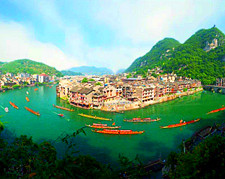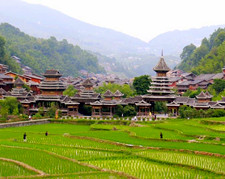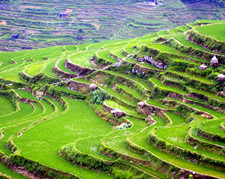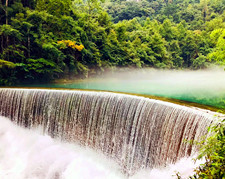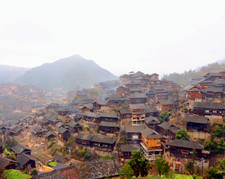Trip Details
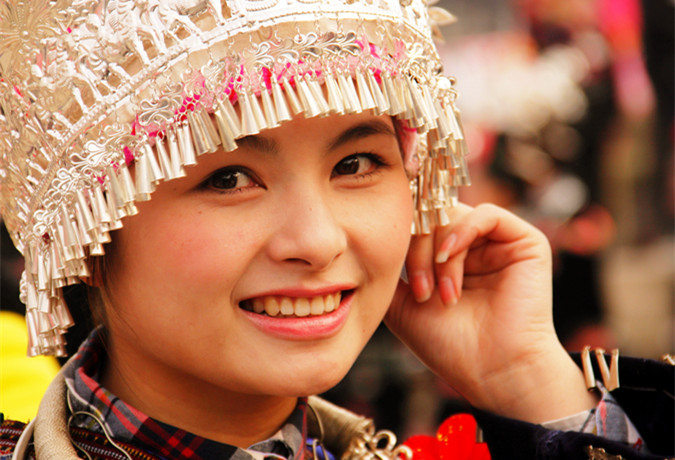
12 Days Photograph the Colorful Guizhou
Date: Oct. 11 to Oct. 22, 2025,2026
Price: From 2800USD/PAX
Trip Focus: Photo + Guizhou
Status: Open to Booking
Route: Guiyang-Mount Fanjingshan-Zhenyuan Ancient Town-Zhaoxing Dong Village-Basha Miao Village-Jiabang Rice Terraces-Libo-Xijiang Miao Village-Duyun-Qingyan Ancient Town-Guiyang
Trip Code: PH005
Overview
Highlights:
• Visiting Mount Fanjingshan which conserves the most complete primeval forest on the same latitude enlisted in UNESCO's World Heritage Sites in 2018. Also, we will not miss the unique ecosystem and karst landscapes of Libo which is Guizhou's first World Heritage Site enlisted in 2007.
• Photographing the colorful minority ethnic groups such as Tujia, Dong, Qiang, and Miao people that live in their villages.
• Exploring the intangible cultural heritage in Shiqiao Village of Danzhai County which is famous for its traditional paper making. In recent years, local papermakers have combined traditional techniques with cultural innovation, making the ancient craft an eye-catcher in the tourism industry.
• Unveiling the secret of "The Last Gunman Tribe in China" by visiting the Basha Village. The Basha men are the only group of people in China that is permitted to carry guns legally.
• Discovering the Chinese paintings by taking photos of the ancient villages, bridges, Jiabang Rice Terraces, and the sunrise and sunset in the mountainous Guizhou.
Introduction to Trip Destinations:
Mount Fanjingshan
Mount Fanjingshan is not only a World Heritage Site but also China's extraordinary holy mountain. Fanjingshan, in Chinese means "Buddhist tranquility". As the ashram of Maitreya Buddha, Mount Fanjingshan is also one of the five most famous Buddhist mountains in China (the other four are Wutai Mountain in Shanxi, Putuo Mountain in Zhejiang, Emei Mountain in Sichuan, and Jiuhua Mountain in Anhui). Fanjingshan is famous for the superlative views from the Golden Summit at 2,572 meters above sea level, the Old Golden Summit at 2,493 meters, and the Red Clouds Golden Summit at 2,336 meters. You will not miss the most photographed Mushroom Stone that stands 10 meters high, as well as many other strange rock formations and stone pillars.
Zhenyuan Ancient Town
Embraced by mountains, Zhenyuan Ancient Town is a hidden gem located in a corner of Kaili, Guizhou Province. Zhenyuan is an ancient town of the Miao people established in 277 BC. It used to be a land-and-water transportation center. Now we can still have the chance to see the preserved ancient buildings built in the Ming Dynasty (1368–1644) which looks like a historic garden. Known as the "Oriental Venice" and cut through by the famous Wuyang River, Zhenyuan Ancient Town is divided into two parts: south "Wei City" and north "Fu City". Walking on the footpaths of the town while photograph its caves, palaces, pavilions, temples, and elegant ancient complex, you will be marveled by this tranquil place.
Zhaoxing Dong Village
Zhaoxing Dong Village is one of the largest Dong minority ethnic group villages in China. Surrounded by verdant mountains with a crystal stream running through, the wooden-stilt houses scattered in the village are brilliant. It says that every Dong village has its drum tower that represents luck and prosperity. Its five drum towers appear as five lotus flowers scattered in five naturally formed villages. Dong People like to gather around drum towers for meetings and entertainment. In 2001, Zhaoxing Dong Village and its drum towers were listed in the Guinness World Records. Would like to experience a special rural life? This Dong village is the best choice.
Basha Village
Basha Village, also called Basha Miao Village or Biasha Miao Village, is famed for being China's last tribe of gunmen that can legally carry real guns in China. This is a village home to over 1,000 residents while hidden away in a forest and filled with stilted wooden houses by the river. The Miao people here lead a self-sufficient life and retain the dressing and living customs hundreds of years ago. They worship trees. A tree is planted at the time when a baby is born and the tree will be cut down to make the coffin when the person eventually dies. Basha men's unique hairstyles have existed for thousands of years and their shaving ceremony (use a sickle to shave hair) is a highlight.
Jiabang Rice Terraces
There are a lot of rice fields in Guizhou, with the most famous being the Jiabang Rice Terraces. As the mysterious terraces with cloud and mist almost every early morning, Jiabang Rice Terraces is an experience not to be missed though it is still unknown to many travelers from the outside world. From generation to generation, the rice terrace farmers of Jianbang are mainly the villagers from the Miao minority ethnic group. So it is a good place to experience ethnic cultures and customs that combines with the peaceful and traditional wooden two-story Miao minority houses and picturesque landscape. We can enjoy mirror-like rice fields in spring, green terraces in summer, and gold terraces in autumn.
Libo Scenic Area (Daqikong and Xiaoqikong)
As Guizhou's first World Heritage Site, Libo Scenic Area mainly consists of the Xiaoqikong (Small Seven-hole Bridge), Daqikong (Large Seven-hole Bridge), Shuichun River and Zhangjiang River Scenic Area. On this trip, we will visit the former two, dubbed "Little Jiuzhaigou". The Xiaoqikong is reputed as a life-size miniature garden. We will photograph the spectacular sights of the ancient stone bridge where the attraction got its name, as well as the water forest there. Daqikong offers the old Big Holes Bridge built in 1850 and its name got from the bridge. Visitors can explore Daqikong for its one-of-a-kind karst valleys, primitive forests, incredible mountains, underground lakes, and rivers.
Xijiang Miao Village
Titled as "thousand-household village", Xijiang Miao Village is the largest Miao village in China. With the surrounding natural beauty, it is a great place to observe traditional Miao culture in this village. In this "Open Air Museum", we can also experience Miao's festivals, singing and dancing, art, language, costumes, silverwork, authentic Miao cuisine, wind and rain bridges, and wooden stilted houses. When night falls and every household turns lights on, you will never miss the chance to photograph the panoramic night view of the picturesque and peaceful village that illuminated like the stars hanging in the sky.
How Can We Make This Trip Special?
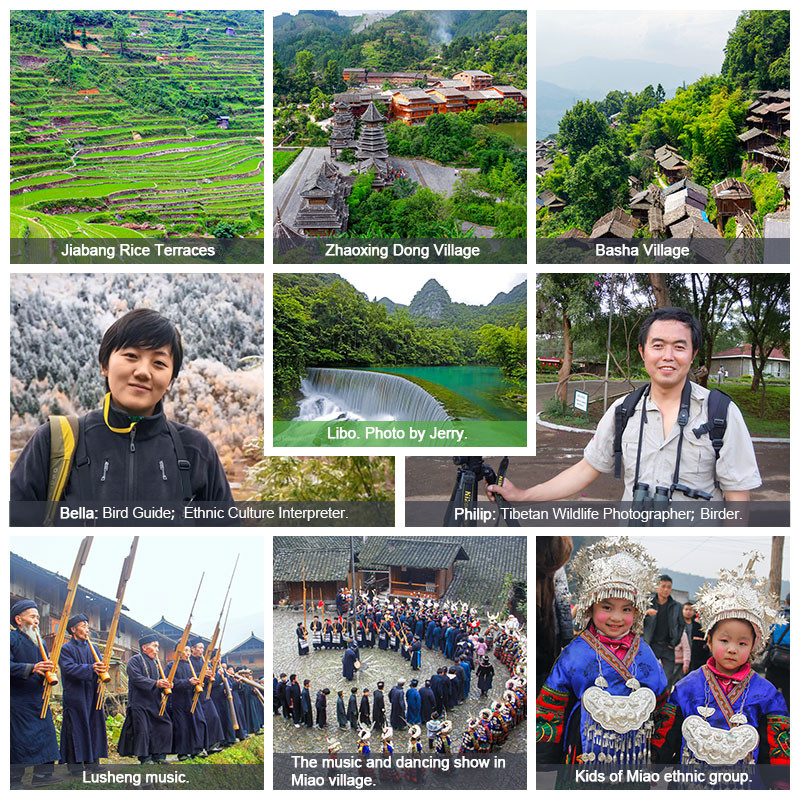
We use AbsolutePanda as company brand because of our deep love toward panda and our determination to create your absolutely enjoyable panda trips.
Map
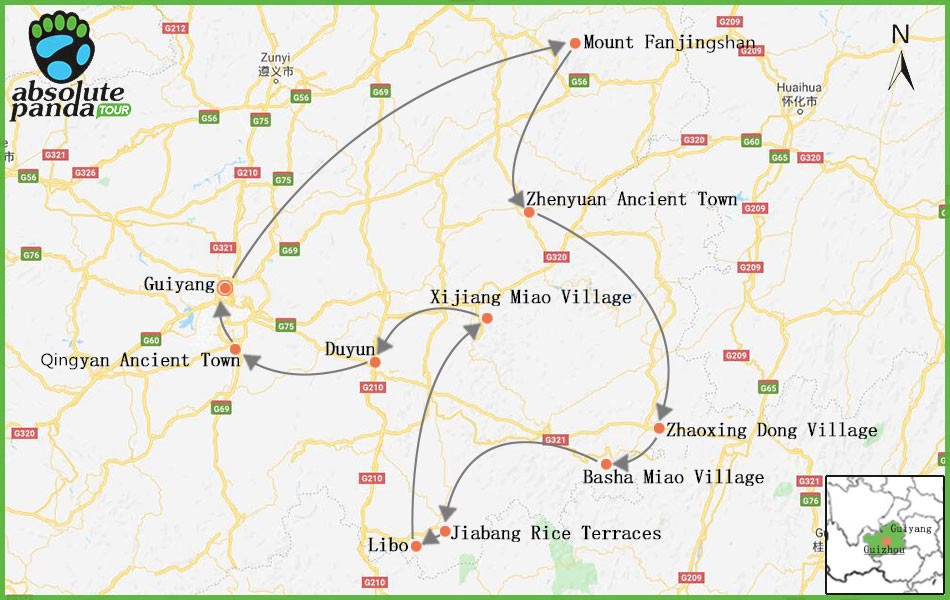
Photograph the Colorful Guizhou Trip Map
Itinerary
Outline:
Day 1. Arrive in Guiyang. (D)
The airport pick-up. City exploration is based on your time of arrival. Overnight: Guiyang
Day 2. Guiyang-Mount Fanjingshan. 290km 4h (BLD)
Drive to Mount Fanjingshan and visit Yunshe Village. Overnight: Fanjingshan
Day 3. Mount Fanjingshan. (BLD)
Visiting Mount Fanjingshan which is a World Heritage Site. Overnight: Fanjingshan
Day 4. Mount Fanjingshan-Zhenyuan Ancient Town. 240km 5h (BLD)
Drive to Zhenyuan Ancient Town after visiting Qishuping Qiang Village. Overnight: Zhenyuan Ancient Town
Day 5. Zhenyuan Ancient Town-Zhaoxing Dong Village. 230km 3.5h (BLD)
Drive to Zhaoxing Dong Village after photographing Zhenyuan Ancient Town in the morning. Overnight: Zhaoxing Dong Village
Day 6. Zhaoxing Dong Village-Jiabang Rice Terraces. 135km 4h (BLD)
Drive to Jiabang Rice Terraces for sunset after visiting Basha Village. Overnight: Jiabang
Day 7. Jiabang Rice Terraces-Libo. 230km 5h (BLD)
Drive to Lobo after photographing Jiabang Rice Terraces in the morning. Overnight: Libo
Day 8. Libo Scenic Area. (BLD)
Visiting the Daqikong and Xiaoqikong of Libo which is Guizhou's first World Heritage Site. Overnight: Libo
Day 9. Libo-Xijiang Miao Village. 250km 4.5h (BLD)
Drive to Xijiang Miao Village via Yao Village. Overnight: Xijiang Miao Village
Day 10. Xijiang Miao Village-Duyun. 160km 3.5h (BLD)
Drive to Duyun after visiting Shiqiao Village for its intangible cultural heritage. Overnight: Duyun
Day 11. Duyun-Guiyang. 150km 4.5h (BLD)
Drive back to Guiyang after visiting Qingyan Ancient Town. Overnight: Guiyang
Day 12. Depart Guiyang. (B)
Airport drop-off.
Details:
Day 1. Arrival in Guiyang. Meals: D
The airport pick-up. Based on the time you arrive, we can plan some free city tour programs such as visiting a park nearby, try local food, and communicate with local people in the market. Guiyang, as the capital city of Guizhou Province, was inhabited as far back as the 7th century. It is situated at an elevation of approximately 1,100m and occupies an area of 8,034 square kilometers. The city experiences a humid subtropical climate. A local proverb says it must rain every three days (Do bring an umbrella with you). It says that the sun is a rarity in Guiyang, and a “precious sun” is the literary translated name of the city.
Overnight: Guiyang
Day 2. Guiyang-Mount Fanjingshan. 290km 4h Meals: BLD
Drive to Mount Fanjingshan and visit Yunshe Village. Located at the foot of Fanjingshan Mountain, by the side of the Taiping River, the Yunshe Village looks like a natural village in a paradise and known as the "China's No. 1 Village for the Tujia Minority". Yunshe means "house in the cloud, the place where the immortal lives". The antique houses with beautiful windows are the most typical Tujia wooden buildings here. The old street of flagstone road winding around the front and back of every family's house like a maze and connecting every family in Yunshe. What a place to get peace of mind.
Overnight: Fanjingshan
Day 3. Mount Fanjingshan. Meals: BLD
Visiting Mount Fanjingshan which is a World Heritage Site. Fanjingshan Mountain is the ashram of Maitreya Buddha and it is one of the five most famous Buddhist mountains in China (the other four are Wutai Mountain in Shanxi, Putuo Mountain in Zhejiang, Emei Mountain in Sichuan, and Jiuhua Mountain in Anhui). Along the way, we can view the scenery of the beautiful Jinjiang River and the picturesque Taiping River. Then, we take a shuttle bus to Yuao Cableway via the Fanjingshan Stele Forest, Longquan Temple, and Heiwan Waterfalls. Overlooking from the cable car, we can photograph the dense jungle, deep gully and stream, and towering mountains in the clouds. Arrive at the Red Cloud Jinding (Hongyun Jinding) and Mushroom Stone and find out the highlight for today. In the late afternoon, we can pay a visit to the Dong village at the foot of Fanjingshan Mountain and photograph the night view of the Drum Tower, a landmark of the Dong village.
Overnight: Fanjingshan
Day 4. Mount Fanjingshan-Zhenyuan Ancient Town. 240km 5h Meals: BLD
In the morning, we will drive to Qishuping Qiang Village near Fanjingshan. The Qishuping Qiang Village is the only village of the Qiang ethnic group that lives together in Guizhou Province. With a history of nearly 500 years, the local people with the same family name of Hu has a history of more than 10 generations. We can visit the Qiang Culture Exhibition Hall and have a taste of its famous pork dish made of radish-feed pig that CCTV once photographed. Then we will head to Zhenyuan Ancient Town. With a history of more than 2,200 years, Zhenyuan Ancient Town is the most time-honored city on the Yunnan-Guizhou Plateau. With the Wuyang River’s "S" shape flow, Zhenyuan Ancient Town is separated into Eight-Diagram tactics, so it is also known as Eight-Diagram Ancient Town. It is recommended to photograph the night scene and Zhusheng Bridge, the landmark of the town.
Overnight: Zhenyuan Ancient Town
Day 5. Zhenyuan Ancient Town-Zhaoxing Dong Village. 230km 3.5h Meals: BLD
Drive to Zhaoxing Dong Village after photographing Zhaoxing Dong Village in the morning. Zhaoxing Dong Village is rated as one of "The World's Most Attractive 33 Tourist Destinations" by National Geographic of the United States. As one of the largest Dong villages in China, there are more than 6,000 residents live in the village. The houses in the village are all stilt houses which are scattered along the river. Drum Tower is the symbol of Dong Village and people gather, socialize, and relax here. Zhaoxing Dong Village is mainly famous for its five drum towers, as well as the ground songs and dances of Dong People.
Overnight: Zhaoxing Dong Village
Day 6. Zhaoxing Dong Village-Jiabang Rice Terraces. 135km 4h Meals: BLD
In the morning, we will pay a visit to Basha Village. The Miao people who live in the Basha Village are known as "The Last Gunner Tribe in China". There are more than 300 families live in the village. Due to its remote location, this village still keeps its ancient and primitive way of life. Basha's most distinctive feature is the Miao man's hairstyle which is the most important symbol of gender in male attire, and they wear guns and waist knives with them. Basha people worship the sun god, so they have the tradition of facing the place where the sun rises, and play the Lusheng and dance. After Basha Village, we will drive to Jiabang Rice Terraces for sunset.
Overnight: Jiabang
Day 7. Jiabang Rice Terraces-Libo. 230km 5h Meals: BLD
Photographing Jiabang Rice Terraces in the morning. Jiabang Rice Terraces are a masterpiece cultivated by Miao people for generations. The rice terraces were made along the mountains and present different beautiful lines with the change of mountain terrain. The villages scattered in the terraced fields are blend in with nature, reflecting the beauty of harmony between humans and nature. Compared with Yuanyang Rice Terraces in Yunnan and Longji Rice Terraces in Guangxi, Jiabang Rice Terraces in Guizhou are not so famous (known by the outside world in 2009), but they are also known as "one of the best-terraced fields in China". Then, we will drive to Libo.
Overnight: Libo
Day 8. Libo Scenic Area. Meals: BLD
Visiting the Daqikong and Xiaoqikong of Libo which is Guizhou's first World Heritage Site. Libo County, characterized by unique karst landscape, mysterious dense forests, various living species, splendid overlapping mountains, and clear rivers and lakes. Because of the well-preserved ecological environment, the area is honored by both Chinese and overseas experts, as "an unparalleled, well-preserved green gem unmatched by any other karst sites in the world". Enjoy a whole day of photographing inside Libo.
Overnight: Libo
Day 9. Libo-Xijiang Miao Village. 250km 4.5h Meals: BLD
After breakfast, we will drive to Yaoshan Lapian Yao Village in Libo. The Baiku (white trousers) Yao ethnic group has been recognized by the UNESCO as the one with the most complete preservation of national culture, and is called as the "living fossil of human civilization". In the afternoon, we will head to photograph the night view of Xijiang Miao Village, the largest Miao village in China. It seems that stars are scattered on the opposite mountain, and you are intoxicated with the Xijiang River at night. Surrounded by mountains, stilted buildings (Diaojiao Lou style) are built along the mountains, the Baishui River passes through the village, and green bamboo is dotted around the house, making it an excellent place for photographing architecture, culture, and scenery.
Overnight: Xijiang Miao Village
Day 10. Xijiang Miao Village-Duyun. 160km 3.5h Meals: BLD
After photographing Xijiang Miao Village in the morning, we will head to Shiqiao Village in Danzhai for its intangible cultural heritage. Shiqiao Village is one of the inheritance places for traditional paper-making. In the village, there are hundreds of craftsmen who have mastered the art of ancient hand-made papers and products. In the afternoon, we will head to Duyun, also known as Bridge City, for the night scene. With the Jianjiang River flows through, Duyun city has many bridges over the water, such as stone arch bridges, iron cable bridges, slab bridges, double-curved arch bridges, and some ancient bridges of unknown names. You will not miss the Baizi Bridge, built in 1786, which is the oldest bridge in Duyun.
Overnight: Duyun
Day 11. Duyun-Guiyang. 150km 4.5h Meals: BLD
After photographing the sunrise in the Bridge City, we will head to Qingyan Ancient Town. Qingyan Ancient Town was built in the Ming Dynasty and has preserved a large number of ancient buildings of the Ming and Qing dynasties. It is one of the four ancient towns of Guizhou and the other three are Zhenyuan Ancient Town, Bingan Ancient Town, and Longli Ancient Town. The exquisite stone carving and wood carving technology in the town is a great attraction. Also, this is a town combine with Buddhism, Taoism, Catholicism, and Protestantism, you can even find a Christian church and a Catholic church here. Then, we will drive back to Guiyang. If time permits we can have a night view of Jiaxiu Tower which is a cultural relic of Guiyang.
Overnight: Guiyang
Day 12. Depart Guiyang. Meals: B
The airport drop-off. On the final day of this tour, our team will escort you to the airport and assist you with luggage check-in.
Notes:
1. If you need help in arranging a flight to Guiyang from other major cities of China such as Beijing, Shanghai, Xian, or a departure flight from Guiyang, please feel free to contact us, we are more than happy to provide any support we can to facilitate your trip planning.
2. The driving hours listed in the itinerary are just for your rough reference.
Dates & Prices
Accommodations
FAQs
1. What's the flavor of Guizhou cuisine?
Guizhou cuisine, also known as Qian cuisine, is most affected by Sichuan cuisine, and it is famous for its sour and spicy taste. Sichuan food is hot and spicy, while most Guizhou dishes are sour and spicy. Guizhou cuisine consists of several flavors such as Guiyang cuisine, Northern Guizhou cuisine, and ethnic minority cuisine. By the early Ming Dynasty, Guizhou cuisine had matured with many dishes dating back more than 600 years.
2. What is the weather like in Guizhou?
Guizhou Province is in the subtropical zone with a humid monsoon climate. The annual average temperature is about 15℃. Due to the high mountains and lush vegetation in the area, its seasons tend to merge with neither severe winter nor hot summer. Do bring an umbrella or raincoat with you as it is said: "sunny weather seldom lasts for more than three days".
3. Is the Huangguoshu Waterfall worth a visit?
Huangguoshu Waterfall is one of the most famous waterfalls in China and it is the largest waterfall in Asia. The waterfall is still quite splendid even in the dry season. Our trip does not include Huangguoshu Waterfall in our route as it is not in the same direction. So if time permits you can add one or two days for an extension trip to the waterfall.
Email us if you have any questions. Read our FAQ
Testimonials
Excellent private tour!
Videos & Photos
Welcome to email us and share your trip video with us. Video Album of AbsolutePanda
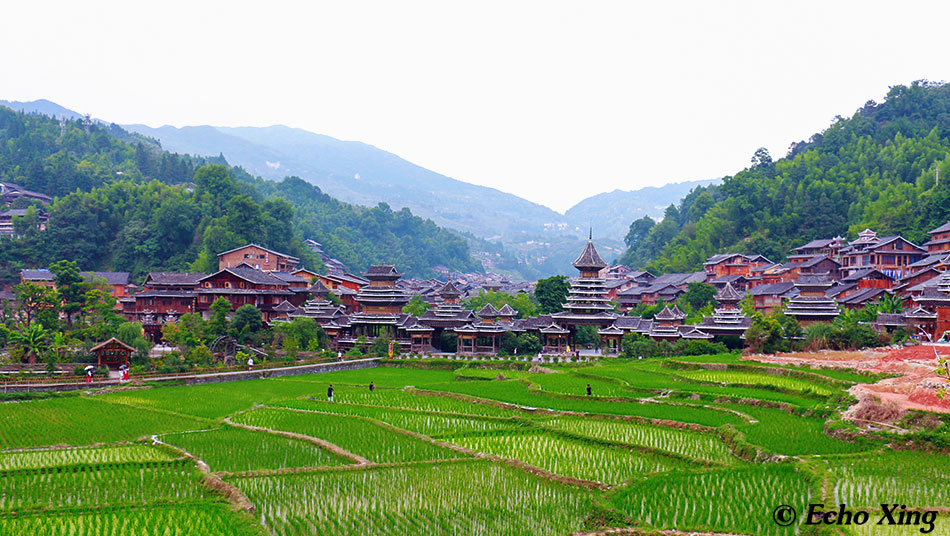
Zhaoxing Dong Village
Zhaoxing Dong Village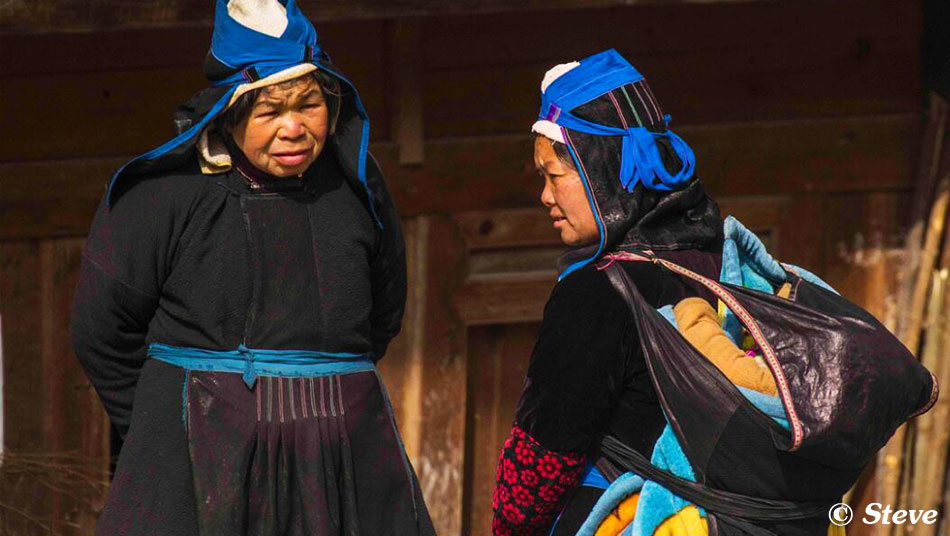
Dong minority ethic group.
Basha Village
Basha man use a sickle to shave hair.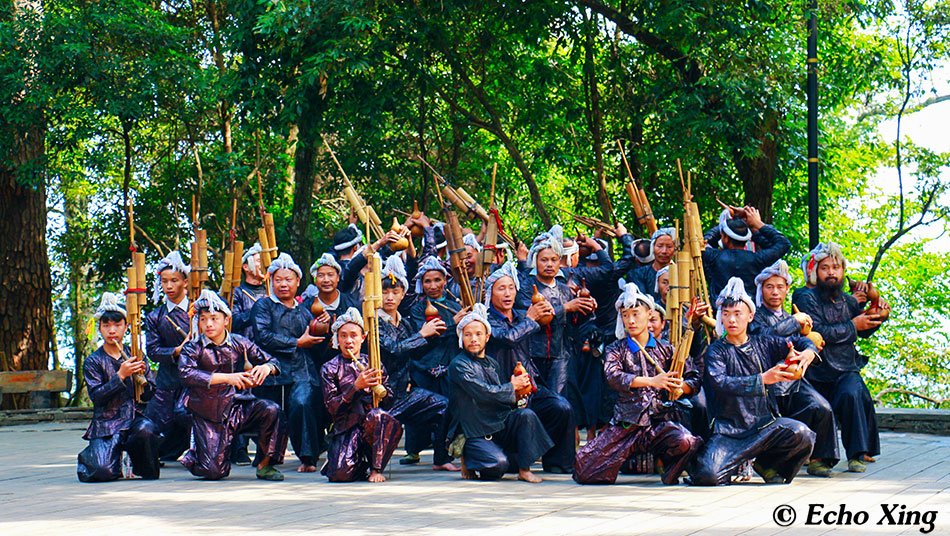
Lusheng music in Basha Village.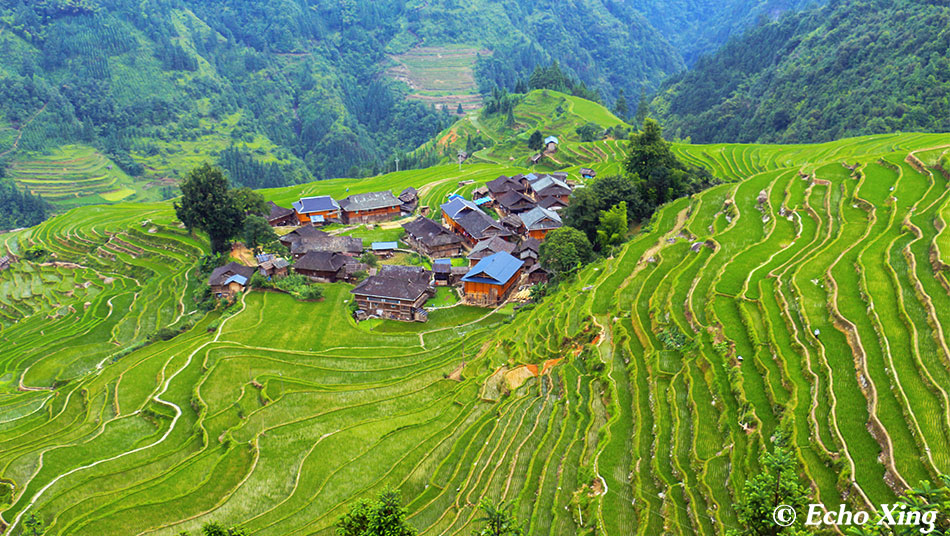
Jiabang Rice Terraces
Libo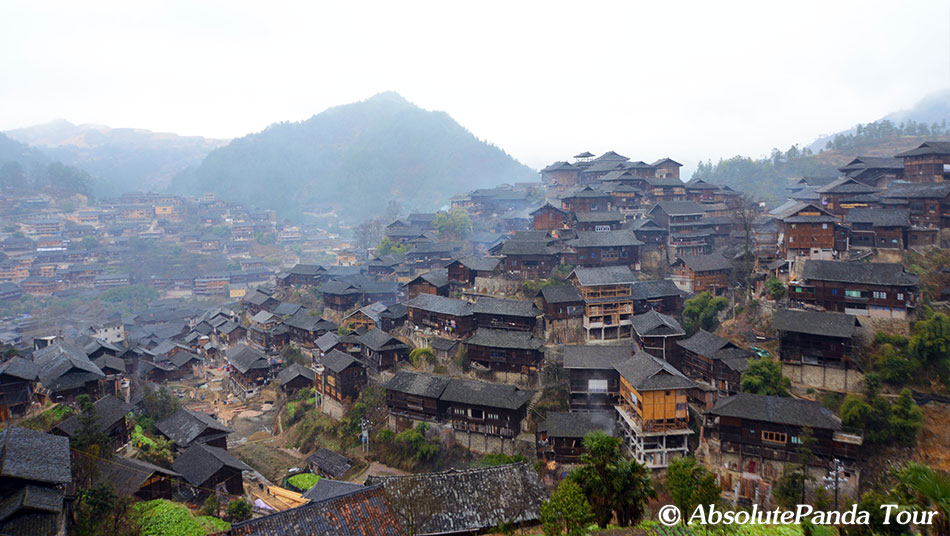
Xijiang Miao Village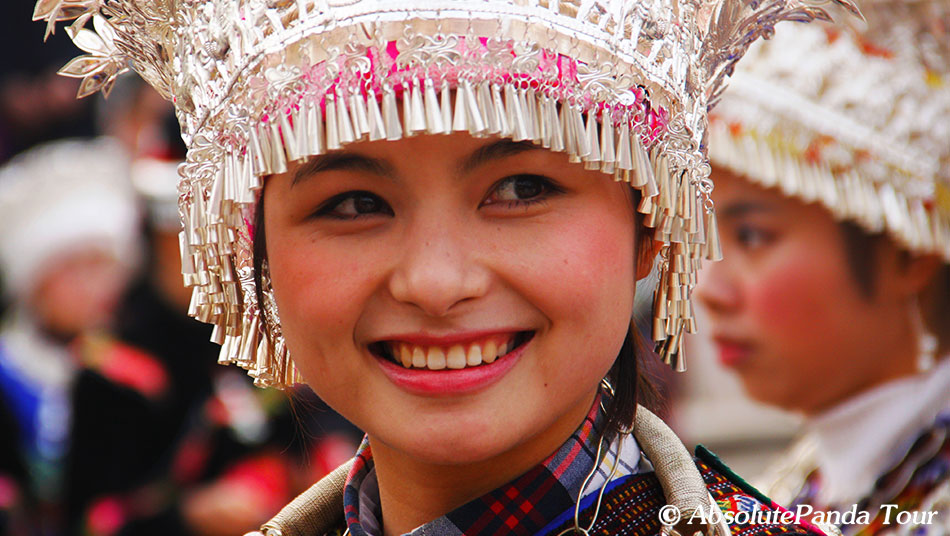
Miao people.
Welcome to email us and share your trip photo with us. Photo Album of AbsolutePanda
 info@absolutepanda.com
info@absolutepanda.com
